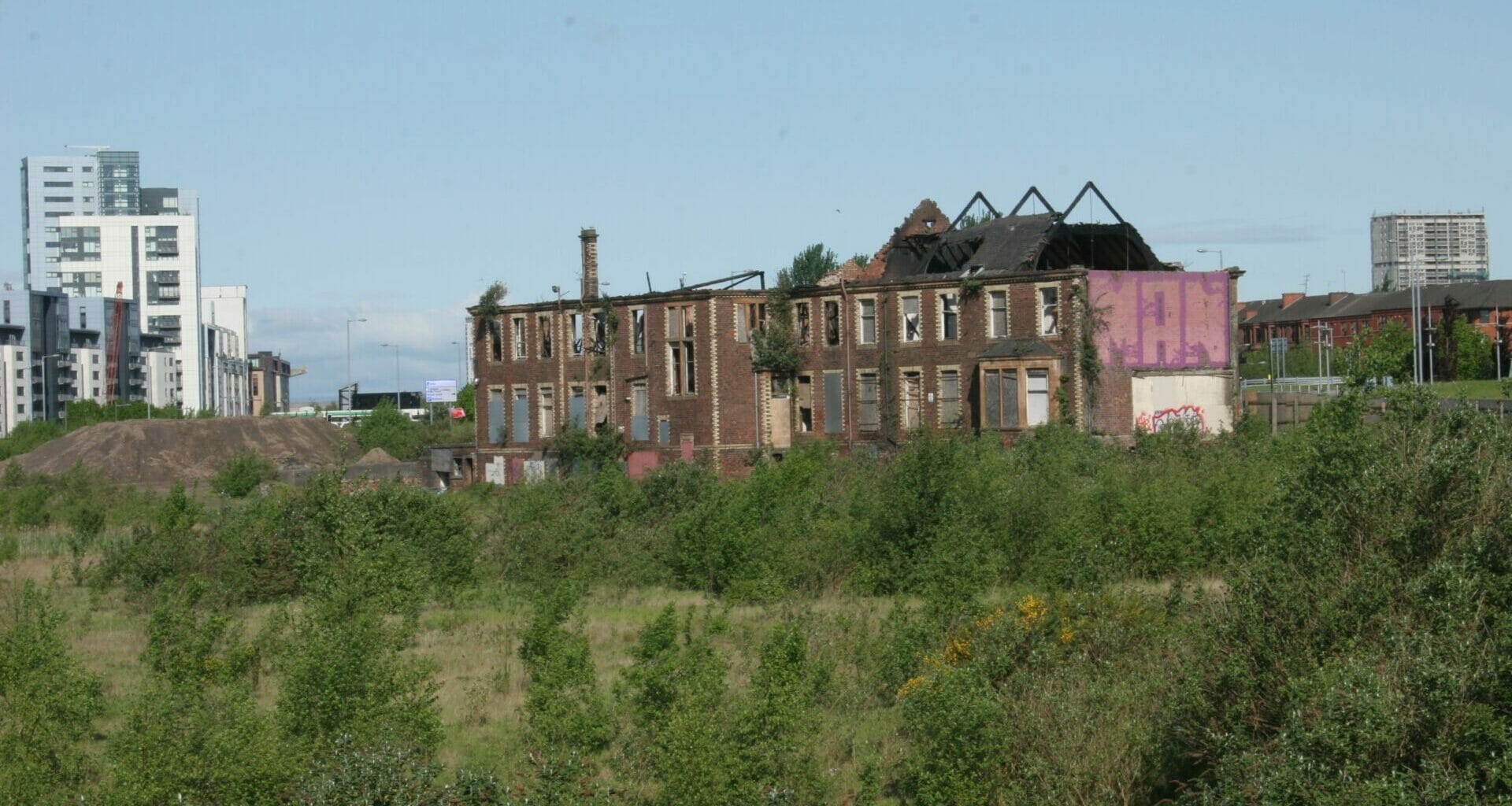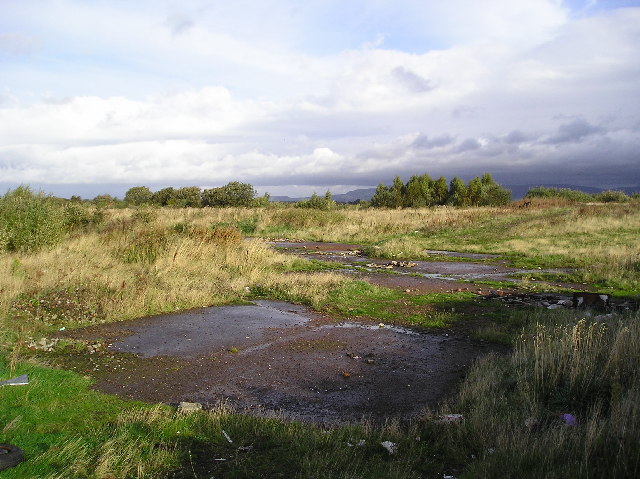The number of vacant and derelict land plots subject to business rates grew in most Scottish council areas in recent years, The Ferret can reveal, prompting opposition parties to call for an end to “perverse incentives” that allow land to fall into disuse.
The public purse is missing out on crucial revenue due to the undertaxing of derelict and vacant landowners and failing to encourage them to remediate disused plots, critics argue.
Derelict land “can be an eyesore in communities, a magnet for anti-social behaviour and a waste of a precious environmental and local resource,” according to the Scottish Greens.
Research compiled by the Scottish Assessors Association (SAA) for The Ferret shows that the number of disused areas increased in most Scottish local authority areas between 2020 and 2023, despite a small drop in the overall number.
Some 2,169 non-domestic properties, which include shops, offices, pubs, warehouses, factories and holiday accommodation, were deemed derelict or vacant in 2023. Seventeen councils saw a rise in the number of derelict plots, 13 saw a fall, and two stayed the same.
Non-domestic derelict land in Scotland is currently valued at more than £10m collectively. But the SAA data also shows there are huge regional variations in how much landowners are charged. In 2023, the projected revenue from the average derelict plot in Glasgow was 432 times less than in Aberdeen.
Opposition parties have branded derelict land “a waste of a precious environmental and local resource” and called for land tax reform to encourage productive use whilst raising public money.
Glasgow continues to have the biggest derelict land problem – a situation the council previously said was owed to the city’s industrial past. It saw the greatest increase, with derelict plots surging from 624 to 784 – a 26 per cent rise.
The city is home to 36 per cent of all Scotland’s derelict plots, but just 0.5 per cent of all the total taxable value of all Scotland’s derelict land. The council charged just £70 for the average derelict site – the second lowest of any council.
However, this is five times higher than the £14 it charged on average in 2020. In total, Glasgow is due £54,500 from 784 derelict sites this year – less than the £55,300 Aberdeenshire expects from just 34 derelict sites.
At the other end of the scale, Aberdeen should make £1.2m from 39 sites in 2023, Edinburgh could generate £2.84m from 99, while Angus should be in line for £156,700 from just six. While Aberdeen looks to take in £30,245 for each site on average, Glasgow was due just £70 – 432 times less.
A Glasgow City Council spokesperson said the amount of registered vacant and derelict land in the city had “fallen year-on-year over the last dozen years or so, and the latest figures suggest this trend is continuing with sites being redeveloped to create new homes, workplaces and public space across the city.”
Other local authorities with notable increases in derelict plots included both Lanarkshire councils, all three in Ayrshire, as well as Aberdeen and Aberdeenshire. Falkirk and Dundee saw the greatest reductions, followed by Edinburgh, Stirling, Fife and West Lothian.
Fourteen councils saw the average rateable values of their derelict land increase, 11 saw theirs fall significantly, while six stayed roughly the same.
The SAA previously said it was common for assessors to tax nothing to derelict landowners when they believed “a hypothetical tenant would not be prepared to offer a rent to occupy”. Factors such as rate relief schemes also mean the projected revenue is not always raised.
The Scottish Land Commission found that undertaxing land “encourages landowners to use land inefficiently” while the Scottish Government’s derelict land taskforce recommended non-domestic rates reform to better incentivise reuse of derelict sites.
COSLA, which represents councils, stressed that business rates are set by the government, with the value of properties decided by local assessors. But while councils collect the revenue, they do not directly benefit from it. The government said Scotland’s derelict land was decreasing and that councils have a range of powers to tackle the issue.
Nationwide progress on derelict land
The 2021 Vacant and Derelict Land Survey – the latest available – found the total amount of derelict and urban vacant land in Scotland decreased by 16 per cent, from 11,268 hectares in 2020 to 9,459 hectares since 2020. This was largely owed to two derelict airfields being used for agriculture, and the naturalisation of 11 derelict opencast coal sites.
Some 20 per cent of all Scottish sites were classified as urban vacant, which is land viewed as appropriate site for development. The other 80 per cent were marked as derelict, as they were deemed to have been damaged by development and required remedial works to bring back into use.
More than half of all disused land in Scotland was located in five authorities. North Lanarkshire had the largest area – 14 per cent of Scotland’s total – followed by North Ayrshire, Glasgow, East Ayrshire and Dumfries and Galloway.
In 2022, the government’s Vacant and Derelict Land Taskforce and the Scottish Land Commission (SLC) “recommended “applying additional reliefs on non-domestic rates (NDRs) and council tax for newly built properties on long standing vacant sites, as well as giving local authorities the power to apply NDRs to newly derelict properties.”
The SLC previously called on the Scottish Government to introduce a compulsory sales order (CSO) for councils to auction long-neglected land and buildings for regeneration. This policy was part of the SNP’s 2016 election manifesto but the government admitted in 2019 that the power would not be delivered in the current parliamentary term.
The SNP’s 2021 manifesto did not promise CSOs, but the Scottish Government told The Ferret it “remains committed to reforming and modernising the compulsory purchase system in Scotland to make it fairer, clearer and faster for all parties.”
The Scottish Greens also back CSOs, which the party argues can “empower local people” and “bring abandoned, neglected and detrimental land back into use.” Regeneration can help communities “tackle poverty and inequality and build community wealth on their own terms”, said Ariane Burgess MSP.
“We need to work with local authorities and other public bodies to ensure that there are plans in place to bring this land back into use,” she said. “That can mean rewilding or as space for housing or other community assets.”
Burgess added: “We need to look at how land is taxed and how landowners are incentivised, but we also need a systematic approach to dealing with sites.”
Scottish Labour’s land reform spokesperson, Rhoda Grant MSP, said: “We need a real land reform plan that includes an end to the perverse incentives that discourages landowners from bringing derelict and vacant land back into use.”
New programme to tackle derelict land
The Scottish Government said that the amount of derelict land had decreased by 28 per cent since 2015 and represents just 0.1 per cent of all Scotland’s land.
Five councils with the greatest amount – Fife, Glasgow, North Ayrshire and North and South Lanarkshire – were due to receive a share of £7.6 in 2023/24 as part of the Vacant and Derelict Land Fund.
In February, the government announced the Vacant and Derelict Land Investment Programme, which awarded 15 projects a share of £10m. This includes £2.4m for the Govan Graving Docks, which have lain empty for more than 40 years.
“Local authorities already have broad compulsory purchase powers to support a range of development and regeneration projects – including bringing vacant, derelict and underused land or property back into productive use,” said a government spokesperson.
The Scottish Conservatives’ land reform spokesperson, Brian Whittle MSP, said: “At a time when public finances are increasingly stretched thanks to cuts by the Scottish Government, it’s hard to fathom why councils wouldn’t be looking harder at ways they could raise more money.
“If it comes with the added benefit of encouraging property owners to start investing in derelict sites so they can make an economic contribution, or sell to someone who will, then so much the better.”
COSLA said councils collect non-domestic rates (NDR) on behalf of the government but do not directly benefit from the revenue collected. “Therefore it is not within the gift of a council to set an alternative charge, other than some recently devolved powers to set and vary reliefs on empty properties,” a spokesperson said.
“Rateable values are determined by assessors (who are independent of councils, though funded by them) and these are multiplied by the rates poundage set by the Scottish Government, in order to arrive at the rates charge. Councils continue to work through initiatives such as the Vacant and Derelict Land Fund, to bring about economic regeneration.”
Header image credit: cc-by-sa/2.0 – © Richard Sutcliffe – geograph.org.uk/p/4963382
















The header image is Linwood shopping centre in Renfrewshire from the early 2000s.
There is no mention of Renfrewshire, Linwood or the gargantuan community effort it took to regenerate the town in your article.
Please consider reviewing the header image selection choice as it does not represent Linwood and is almost 20 years old.
Hi John, sorry I didn’t spot your comment right away. I’ve just updated the header image.